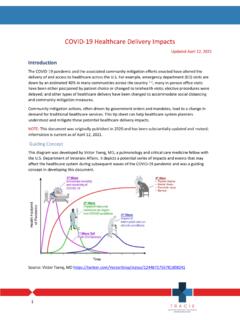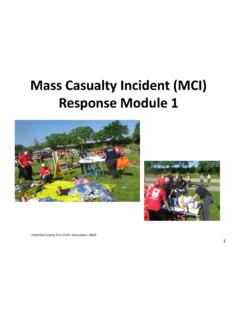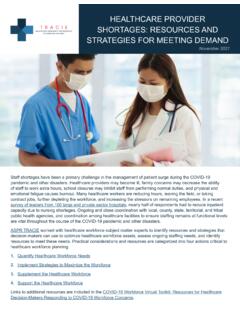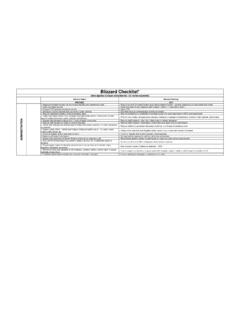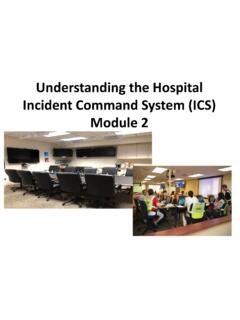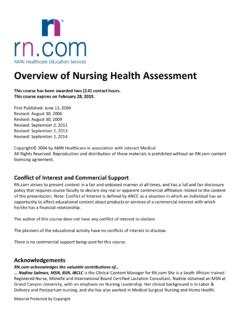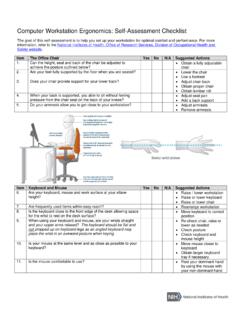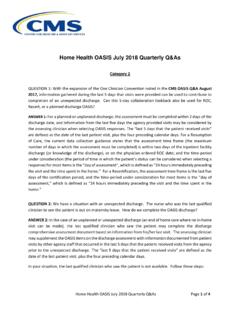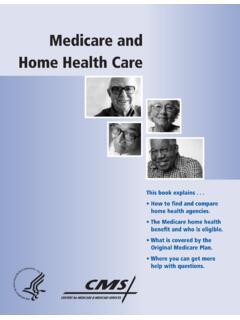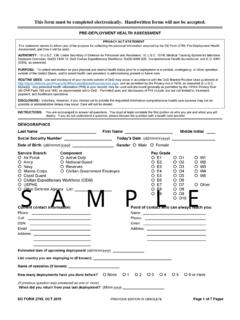Transcription of Home Health Agency Requirements - United States …
1 TRACI E home Health Agency Requirements CMS emergency preparedness Final Rule Updates Effective March 26, 2021 The Centers for Medicare & Medicaid Services (CMS) issued the emergency preparedness Requirements for Medicare and Medicaid Participating Providers and Suppliers Final Rule to establish consistent emergency preparedness Requirements for healthcare providers participating in Medicare and Medicaid, increase patient safety during emergencies, and establish a more coordinated response to natural and human-caused disasters. The Department of Health and Human Services Office of the Assistant Secretary for preparedness and Response (ASPR) worked closely with CMS in the development of the rule. This document combines excerpts from the Final Rule and Interpretive Guidelines (as updated , , and ) from CMS to provide a consolidated overview document for the Hospital and Transplant Program Requirements .
2 This document reflects final language as of the most recent Final Rule updates and Interpretive Guidance updates as of March 26, 2021. For a comparison of changes between past versions, please review the Interpretive Guidelines published by CMS on March 26, 2021. This document is meant as a reference and is NOT intended to replace your review of the Final Rule or the Interpretive Guidance documents and speaking with your surveyor or accrediting body. This document may contain references or links to statutes, regulations, or other policy materials. The information provided is only intended to be a resource. It is not intended to take the place of either the written law or regulations. We encourage readers to review the specific statutes, regulations, and other interpretive materials for a full and accurate statement of their contents. Quick Links emergency preparedness Requirements for Medicare and Medicaid Participating Providers and Suppliers Final Rule Burden Reduction Final Rule (effective November 29, 2019) Interpretive Guidelines (as of March 26, 2021) Interpretive Guidelines Surveyor Cheat Sheet Quick Links emergency preparedness Requirements for Medicare and Medicaid Participating Providers and Suppliers Final Rule Interpretive Guidelines and revisions Interpretive Guidelines Surveyor Cheat Sheet 1 TRACI E In this document.
3 HHA Requirements as Written in the Final Rule emergency Plan Policies and Procedures Communications Plan Training and Testing Integrated Healthcare Systems HHA Requirements as Written in the Interpretive Guidelines 2 TRACI E HHA Requirements as Written in the Final Rule and as amended by 2019 Burden Reduction (November 2019) The following excerpt is taken from page 64033 of the Final Rule, accessible directly by this link: and Medicare and Medicaid Programs; Regulatory Provisions To Promote Program Efficiency, Transparency, and Burden Reduction; Fire Safety Requirements for Certain Dialysis Facilities; Hospital and Critical Access Hospital (CAH) Changes To Promote Innovation, Flexibility, and Improvement in Patient Care published September 30, 2019 and effective November 29, 2019. PART 484 home Health SERVICES authority citation for part 484 continues to read as follows: Authority: Secs.
4 1102 and 1871 of the Social Security Act (42 1302 and 1395(hh)) unless otherwise indicated. 25. Add to subpart B to read as follows: emergency preparedness . The HHA must comply with all applicable Federal, State, and local emergency preparedness Requirements . The HHA must establish and maintain an emergency preparedness program that meets the Requirements of this section. The emergency preparedness program must include, but not be limited to, the following elements: (a) emergency plan. The HHA must develop and maintain an emergency preparedness plan that must be reviewed, and updated at least every 2 years. The plan must do all of the following: 1) Be based on and include a documented, facility-based and community-based risk assessment , utilizing an all-hazards approach. 2) Include strategies for addressing emergency events identified by the risk assessment . 3) Address patient population, including, but not limited to, the type of services the HHA has the ability to provide in an emergency ; and continuity of operations, including delegations of authority and succession plans.
5 4) Include a process for cooperation and collaboration with local, tribal, regional, State, and Federal emergency preparedness officials' efforts to maintain an integrated response during a disaster or emergency situation. (b)Policies and procedures. The HHA must develop and implement emergency preparedness policies and procedures, based on the 3 TRACI E emergency plan set forth in paragraph (a) of this section, risk assessment at paragraph (a)(1) of this section, and the communication plan at paragraph (c) of this section. The policies and procedures must be reviewed and updated at least every 2 years. At a minimum, the policies and procedures must address the following: 1) The plans for the HHA's patients during a natural or man-made disaster. Individual plans for each patient must be included as part of the comprehensive patient assessment , which must be conducted according to the provisions at 2) The procedures to inform State and local emergency preparedness officials about HHA patients in need of evacuation from their residences at any time due to an emergency situation based on the patient's medical and psychiatric condition and home environment.
6 3) The procedures to follow up with on-duty staff and patients to determine services that are needed, in the event that there is an interruption in services during or due to an emergency . The HHA must inform State and local officials of any on-duty staff or patients that they are unable to contact. 4) A system of medical documentation that preserves patient information, protects confidentiality of patient information, and secures and maintains the availability of records. 5) The use of volunteers in an emergency or other emergency staffing strategies, including the process and role for integration of State or Federally designated Health care professionals to address surge needs during an emergency . (c)Communication plan. The HHA must develop and maintain an emergency preparedness communication plan that complies with Federal, State, and local laws and must be reviewed and updated at least every 2 years. The communication plan must include all of the following: 1) Names and contact information for the following: i.
7 Staff. ii. Entities providing services under arrangement. iii. Patients' physicians. iv. Volunteers. 2) Contact information for the following: i. Federal, State, tribal, regional, or local emergency preparedness staff. ii. Other sources of assistance. 3) Primary and alternate means for communicating with the HHA's staff, Federal, State, tribal, regional, and local emergency management agencies. 4) A method for sharing information and medical documentation for patients under the HHA's care, as necessary, with other Health care providers to maintain the continuity of care. 5) A means of providing information about the general condition and location of patients under the facility's care as permitted under 45 CFR (b)(4). 4 TRACI E 6) A means of providing information about the HHA's needs, and its ability to provide assistance, to the authority having jurisdiction, the Incident Command Center, or designee.
8 (d)Training and testing. The HHA must develop and maintain an emergency preparedness training and testing program that is based on the emergency plan set forth in paragraph (a) of this section, risk assessment at paragraph (a)(1) of this section, policies and procedures at paragraph (b) of this section, and the communication plan at paragraph (c) of this section. The training and testing program must be reviewed and updated at least every 2 years. 1) Training program. The HHA must do all of the following: i. Initial training in emergency preparedness policies and procedures to all new and existing staff, individuals providing services under arrangement, and volunteers, consistent with their expected roles. ii. Provide emergency preparedness training at least every 2 years. iii. Maintain documentation of all emergency preparedness training. iv. Demonstrate staff knowledge of emergency procedures. v. If the emergency preparedness policies and procedures are significantly updated, the HHA must conduct training on the updated policies and procedures.
9 2) Testing. The HHA must conduct exercises to test the emergency plan at least annually. The HHA must do the following: i. Participate in a full-scale exercise that is community-based; or (A) When a community-based exercise is not accessible, conduct an annual individual, facility-based functional exercise every 2 years; or. (B) If the HHA experiences an actual natural or man-made emergency that requires activation of the emergency plan, the HHA is exempt from engaging in its next required full-scale community-based or individual, facility based functional exercise following the onset of the emergency event. ii. Conduct an additional exercise every 2 years, opposite the year the full-scale or functional exercise under paragraph (d)(2)(i) of this section is conducted, that may include, but is not limited to the following: (A)A second full-scale exercise that is community-based or an individual, facility-based functional exercise; or (B)A mock disaster drill; or (C)A tabletop exercise or workshop that is led by a facilitator and includes a group discussion, using a narrated, clinically-relevant emergency scenario, and a set of problem statements, directed messages, or prepared questions designed to challenge an emergency plan.
10 Iii. Analyze the HHA s response to and maintain documentation of all drills, tabletop exercises, and emergency events, and revise the HHA s emergency plan, as needed. 5 TRACI E (e)Integrated healthcare systems. If a HHA is part of a healthcare system consisting of multiple separately certified healthcare facilities that elects to have a unified and integrated emergency preparedness program, the HHA may choose to participate in the healthcare system's coordinated emergency preparedness program. If elected, the unified and integrated emergency preparedness program must do all of the following: 1) Demonstrate that each separately certified facility within the system actively participated in the development of the unified and integrated emergency preparedness program. 2) Be developed and maintained in a manner that takes into account each separately certified facility's unique circumstances, patient populations, and services offered.
